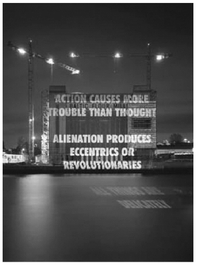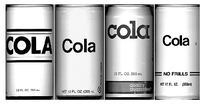Graffiti and Text Art
Sometimes it was as simple as thinking of people I knew and
trying to write a version of what came out of their mouths.
The reason I wrote from every point of view—Far Left, Far
Right, common-sense, lunatic—was that I thought it was a
more accurate way of portraying people’s beliefs, and maybe
a better way than always having didactic or dogmatic stuff.
I thought that—and this is utopian—it might be a more
effective way to have people consider these issues and not
turn them off. A lot of times when something is identifi-
ably Right, or Left, the people who agree with it will agree
with it, and the people who don’t will dismiss it instantly.
I thought it might be more mysterious and less off-putting
if a universe of opinion were laid out, with all sentences
equally weighted—which in a way is a sign of respect for
the audience. Each person coming to this universe will have
to find his or her way through it.
—Jenny Holzer
In the early nineties, first in Providence, Rhode Island, and then up and down the eastern seaboard, thousands of paper, and later vinyl, stickers began proliferating in the urban commercial-detritus/graffiti collage of lampposts, subway entrances, and construction-site billboards. The stickers presented a blunt little graphic, a visage of testosteroid hostility, recognizable to some as the masked face of the professional wrestler Andre the Giant, accompanied by various slogans—most often ANDRE THE GIANT HAS A POSSE.
After a 1994 lawsuit denied use of the wrestler’s name, the reworked stickers took up a They Live theme: the wrestler’s face was now accompanied by the single command OBEY. The sticker campaign was eventually credited to the street artist Shepard Fairey, who’d created them with his schoolmates while a student at the Rhode Island School of Design. Fairey’s famous now as a lawsuit-stricken imagery poacher, creator of the iconic Barack Obama CHANGE poster; he’s as mediocre a poster boy for “appropriation aesthetics” as 2 Live Crew, whose sample of Roy Orbison’s “Pretty Woman” thrust them into the Open Source vanguard, such as it was, in 1989. Fairey’s stickers could be seen as a guerrilla-subliminal ad campaign for They Live, reinscribing the film’s motif of icons of persuasion hidden in plain sight: our overlord’s commands are visible if you know where to look. And we, the underground, make ourselves known to one another by outlawed modes: pirate broadcasts, signal jamming, samizdat pamphlets, graffiti. (Fairey’s They Live reference also puns on Roddy Piper’s career as a pro wrestler.)
They Live displays no fewer than four layers of public textual stuff. Three are under the filmmakers’ control. First, the Matrix layer of manipulative fictions: the magazines, newspapers, and billboards for computers and vacations in the Caribbean. Second, the unmasked truth of obnoxious commands hidden beneath: OBEY, WATCH TV, HONOR APATHY, DOUBT HUMANITY, etcetera. Third, fake graffiti scrawls: THEY LIVE, WE SLEEP. The fourth layer, imposed by the documentary effects of location shooting, and probably exaggerated by a budget prohibiting Antonioni-esque impulses to repaint the world, consists of whatever text was randomly immortalized in the camera’s passing gaze: actual signage (like the freight train reading SHOCK CONTROL), or legitimately illegitimate graffiti (like the gnomic, concrete-poetic PARK CENT on the side of the Dumpster in Nada’s alley).
Such accidental documentation isn’t always negligible: my brother and other graffiti-artists-turned-graffiti-historians pore over those vintage New York City location films that contain subway scenes, like The French Connection, Death Wish, and The Taking of Pelham, 1,2,3, ferreting out lost traces of their subculture’s origins. They Live’s special interest in fugitive modes of discourse isolates these random captures in a charged neutral zone. It’s as if some third constituency, neither enchanted nor disenchanted by the alien broadcast, occupies the same city invisibly, and has sent SHOCK CONTROL and PARK CENT out as signs of their existence. Call this third constituency “the Real.”
Fairey’s interventions occupy the same uneasy middle ground as They Live itself: on the one hand, the termite arts of graffiti or of the deliberate B-movie, marginal activities carrying a subversive potential past the sentries of high art. On the other, the gallery-ready postures of text artists like Barbara Kruger and Jenny Holzer, or of the Cahiers table of “conscious” auteurs—Hitchcock being the supreme example—at which Carpenter may occasionally be granted a shaky seat. Too poised and context-aware to be claimed as primitives, too crass and populist to be comfortably claimed for the high-art pantheon, Fairey and Carpenter both oscillate dismayingly in the void between.

Once, by chance, I attended a baseball game at San Francisco’s Candle-stick Park at which Jenny Holzer had been commissioned to “appropriate” the stadium’s LED signs for her own artistic-subversive purposes. The vast and unfamiliar venue and audience was meant to exfoliate Holzer’s art into the larger world. Being a Holzer fan, and learning of the planned intervention at the baseball game, I anticipated great things. My companion at the game knew nothing of Holzer’s work, so I strained to set up his expectations. But the effort fizzled. When Holzer’s enigmas crawled past on the signs, they died in the stadium’s open-air light and the visual and auditory noise, baseball’s common denominators. They’d become merely ineffectively opaque announcements, or advertisements for products we couldn’t buy.
The discourse of commerce is a kind of quicker-picker-upper, superabsorbent of what happens along, even (or especially) that which presents itself as oppositional to, or critical of, commercial culture. So, much of Barbara Kruger’s and Holzer’s impact was gently naturalized within advertising language. This awkward fact cuts against They Live’s central assertion: that the distance between the “lies” of commercial-ideological speech and the coercive “truths” smuggled inside it is an extreme one, and shattering to cross. Really, the two coexist and even mate with appalling ease (Recall the “ironic” generic packaging that was faddish in the eighties—cigarettes labeled CIGARETTES, and so on—that claimed to deny the sizzle of advertising allure in favor of the steak of gratified desire). Kruger and Holzer’s non sequitur interventions briefly attained a gallant purity, but they’d always needed the gallery or museum context as a quarantine against recontamination. Their work degenerated anyway, refamiliarizing into po-mo moral rhetoric, or reappropriated for fashion layouts. What makes Shepard Fairey’s populist gesture insipid is how self-evidently it awaited a product retrofit, a proceed-to-checkout button. When the OBEY T-shirt or CHANGE political campaign rolled out, no one, least of all the “artworks” themselves, even hiccupped.



